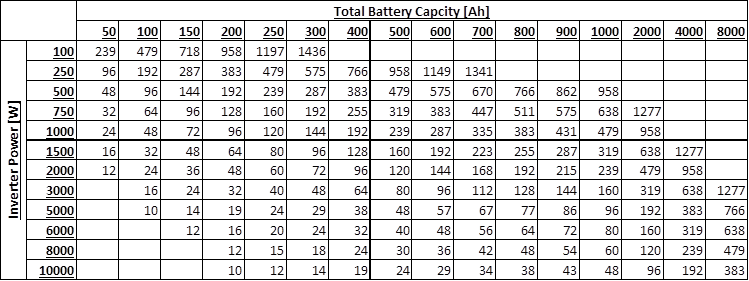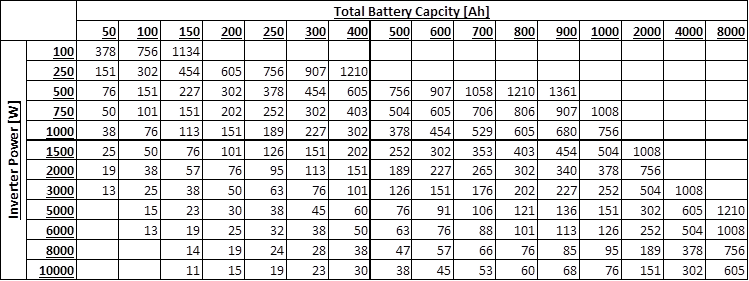Determining how long your solar or backup system’s batteries will last depends on a number of things; the total battery capacity, the amount of power being drawn, the inverter efficiency and the depth of battery discharge. These tables will assist you in estimating how long your batteries will last after they have been fully charged.
The following table gives you an idea of how long your power system will be able to provide power, in minutes. This table assumes an inverter efficiency of 95% (pure sine wave), the inverter is providing its rated output power and that the batteries are discharged to 30% of their original capacity. To use this table, the system voltage does not matter as long as you add up the amp hours of all of the 12V supply batteries. For example if you have two 105Ah batteries in series providing 24 volts for your system, you would look at the 210Ah column in the table. All times shorter than 10 minutes and longer than 1440 minutes (a 24hr day) have been removed.
This table gives you an idea of how long your power system will last operating at 60% of the inverters rated power output. The efficiency is reduced to an average of 90% working at a lower power output. All other parameters are the same as in the above table.
Alternately you can use these tables backwards to determine how many batteries you need. Find your inverter size in the column on the left, then the column with the numbers of minutes you require it to run for and then read up the total amp hours which will give you the total battery capacity required. A standard 12V deep cycle battery is usually 105Ah so divide the total required capacity by 105 and that will give you the number of batteries required.
Here is a guide on selecting the correct inverter size for your solar or backup power system.
Do you have any tips, comments or suggestions? Please share them with us in the comments section below, we would love to hear from you.




Putting 2 batteries in series does NOT double the number of Ah; putting them in parallel does…
Perhaps the description was not entirely clear, I have amended it now. I did not mean that putting two batteries in series doubles the Ah, I was stating that for the purpose of using the table, it does not matter whether your batteries are connected in series or parallel and that if they are used in series then you should still add up the Ah and the table will give you the correct results.
In practice, yes, connecting two batteries in series doubles the voltage and keeps the Ah the same while connecting them in parallel keeps the voltage the same and doubles the Ah.
This is the most Useful Table I have met online
So can the table be trusted if both voltage and amps were doubled?
Hi Jeff, the table is unrelated to voltage and amps. It asks you to add up the amp hours of all of your 12V batteries combined and use this figure to lookup in the table. If you are using individual batteries of a different voltage then the table will not work without further manipulation.
This was helpful, thanks!
DYI writing about solar batteries “lasting” suggests a much more important question than “output between charges” what is actually addressed. Even though available battery technology choices that are economically viable are few, the lifespan of your largest cost component, after the panels of sv cells, is critical to understand. Storage batteries will last at best 2-3 years and require full replacement plus maintenance and the additional costs of cabling, inverter/charger, and maintenance as well as shelter. That’s why few choose to go off-grid unless they have limited or extremely expensive ways to go on-grid. While 50-year batteries can be had (e.g. Nickel- Iron) they require regular addition of water, are heavy, and yield 1.2 volts/cell. They do withstand deeper discharge than most, and have proven 50 years plus of use with refurbishment to full capacity economical and DYI capable. Other, more energy dense technologies like lead-acid will likely have shorter lives than in autos, while Li-ion remains expensive and potentially dangerous.
Interesting. I am looking into solar panels for my home, but need more info on batteries.
Hi Paul, are you looking for more information on choosing the size and number of batteries or on which battery technology to choose?